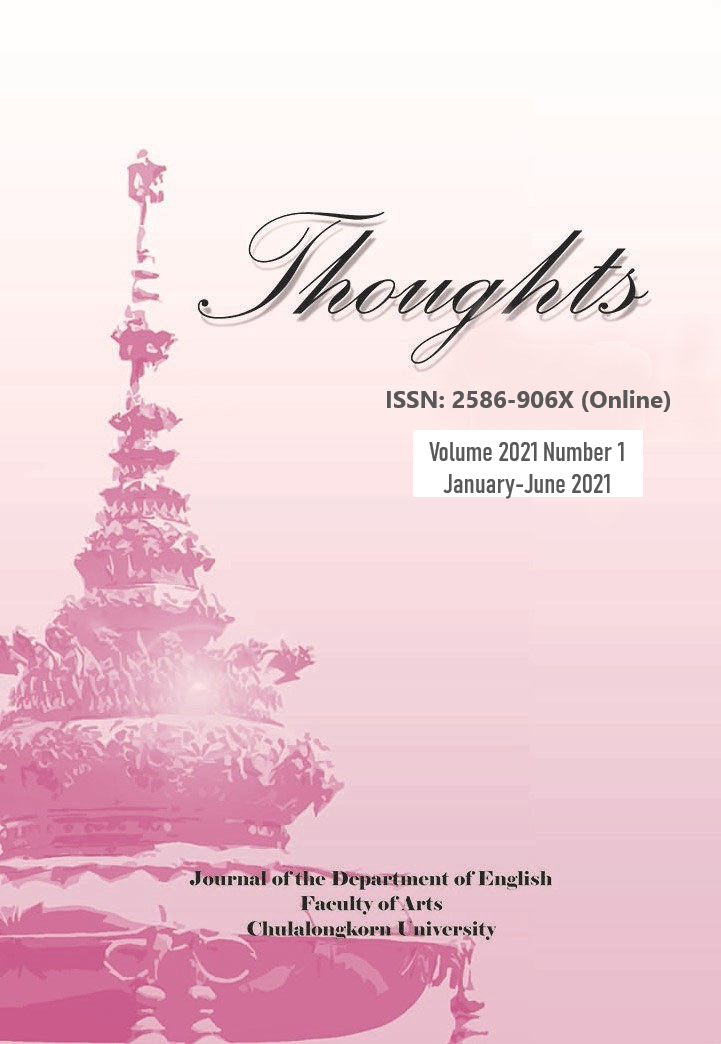Spurious Be in Thai Learners’ L2 Grammars
DOI:
https://doi.org/10.58837/CHULA.THTS.2021.1.3Keywords:
spurious be, L2 tense and phi, L2 lexical main verbs, Thai EFL learners, IP in L2Abstract
This paper is data oriented; it attempts to determine the status of be preceding bare VP and NegP complements, in data obtained from written expressions of 32 Thai EFL students. As this spurious be has not been examined intensively and its status is crucial to understanding L2 acquisition of tense and agreement, this study conducted a systematic investigation of this issue. Having employed data related to IP and CP, it claims that spurious be is restricted to IP, and is inserted into Infl, in the Do-support fashion. Spurious be is triggered by not and finiteness. Supporting evidence involves the fact that spurious be occurs in the absence of do, in conjunction with uninflected lexical main verbs. It is claimed that L2 learners are not influenced by their L1, have access to functional categories available from UG, and apply insertion of be exclusively for IP.
References
Bailey, N., Madden, C., & Krashen, S. D. (1974). Is there a “natural sequence” in adult second language learning? Language Learning, 24(2), 235-243.
Baker, C. L. (1995). English syntax (2nd ed.). MIT Press.
Burt, M. K., Dulay, H. C., & Hernández-Chávez, E. (1973). Bilingual Syntax Measure (Restricted Edition). Harcourt Brace Jovanovich.
Burzio, L. (1986). Italian syntax: A government-binding approach. Reidel.
Chomsky, N. (1981). Lectures on Government and Binding. Foris.
Chomsky, N. (1995a). Some notes on economy of derivation and representation. In The minimalist program (pp. 129-166). MIT Press. (Reprinted from Principles and parameters in comparative grammar, pp. 417-454, by R. Freidin, Ed., 1991, MIT Press)
Chomsky, N. (1995b). The minimalist program. MIT Press.
Epstein, S., Flynn, S., & Martohardjono, G. (1996). Second language acquisition: Theoretical and experimental issues in contemporary research. Behavioral and Brain Sciences, 19(4), 677-714.
Hirakawa, M. (1995). L2 acquisition of English unaccusative constructions. In D. MacLauglin & S. McEwan (Eds.), Proceedings of the Annual Boston University Conference on Language Development 19 (pp. 291-302). Cascadilla Press.
Harris, J. W. (1986). Expanding the superstrate: Habitual aspect markers in Atlantic Englishes. English World-Wide, 7(2), 171-199.
Hornstein, N., Nunes, J., & Grohmann, K. K. (2005). Understanding Minimalism. Cambridge University Press.
Kanlapana, N., & Singhapreecha, P. (2014, May 31). Arrive easier than collapse: Evidence from Thai EFL learners [Paper presentation]. The 14th Annual Conference of the Japan Second Language Association (J-SLA 2014),
Kwansei Gakuin University, Nishinomiya Uegahara Campus, Osaka, Japan.
Kim, J. T. (2007). Semantic aspects in L2 English overpassivization. The linguistic Association of Korea Journal, 15(4), 55-76.
Koopman, H., & Sportiche, D. (1991). The position of subjects. Lingua, 85, 211-258.
Larsen-Freeman, D. (1975). The acquisition of grammatical morphemes by adult ESL students. TESOL Quarterly, 9(4), 409-419.
Lee, S.-Y. (2008). Argument-adjunct asymmetry in the acquisition of inversion in wh questions by Korean learners of English. Language Learning, 58(3), 625–663.
Oshita, H. (2000). What is happened may not be what appears to be happening: A corpus study of ‘passive’ unaccusatives in L2 English. Second Language Research, 16(4), 293-324. https://doi.org/10.1177%2F026765830001600401
Ouhalla, J. (1994). Transformational grammar: From rules to Principles and Parameters. St. Martin's Press.
Pollock, J. -Y. (1989). Verb movement, UG and the structure of IP. Linguistic Inquiry, 20(3), 365-424.
Pozzan, L. (2011). Asking questions in learner English: First and second language acquisition of main and embedded interrogative structures [Unpublished doctoral dissertation]. City University of New York.
Radford, A. (1998). Syntax: A minimalist introduction. Cambridge University Press.
Rickford, J. R. (1986). Social contact and linguistic diffusion: Hiberno-English and New World Black English, Language, 62(2), 245-289.
Schwartz, B. D., & Sprouse, R. A. (1996). L2 cognitive states and the Full Transfer/Full Access model. Second Language Research, 12(1), 40-72.
Simargool, N. (2006). What is happening to what was happened? PASAA, 39, 49-69.
Singhapreecha, P. (2000). The acquisition of case, tense, and agreement features: A study of Thai learners of English [Unpublished doctoral dissertation]. City University of New York.
Trask, R. L. (1993). A dictionary of grammatical terms in linguistics. Routledge.
Vainikka, A, & Young-Scholten, M. (1994). Direct access to X’-theory: Evidence from Turkish and Korean adults learning German. In T. Hoekstra & B. D. Schwartz. (Eds.), Language acquisition studies in generative grammar (pp. 265-316). John Benjamins.
Vainikka, A., & Young-Scholten, M. (1996). Gradual development of L2 phrase structure. Second Language Research, 12(1), 7-39.
Wongwattana, U. S. (2015). Complexities of Thai copular constructions. Journal of the Southeast Asian Linguistics Society, 8, 97-120. http://hdl.handle.net/1885/95200
Downloads
Published
Issue
Section
License
Copyright (c) 2021 Thoughts

This work is licensed under a Creative Commons Attribution-NonCommercial-NoDerivatives 4.0 International License.
Copyright by the Faculty of Arts, Chulalongkorn University.
Photocopying is allowed for internal, non-commercial use only. Photocopying for other uses or for purposes other than indicated must be permitted in writing from the Faculty of Arts, Chulalongkorn University.
All views or conclusion are those of the authors of the articles and not necessarily those of the publisher or the editorial staff.


